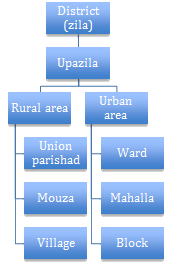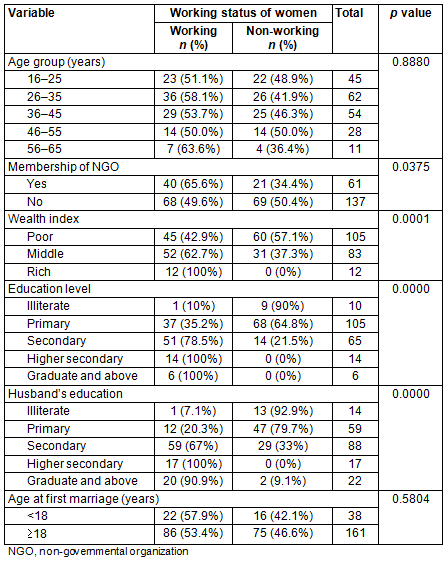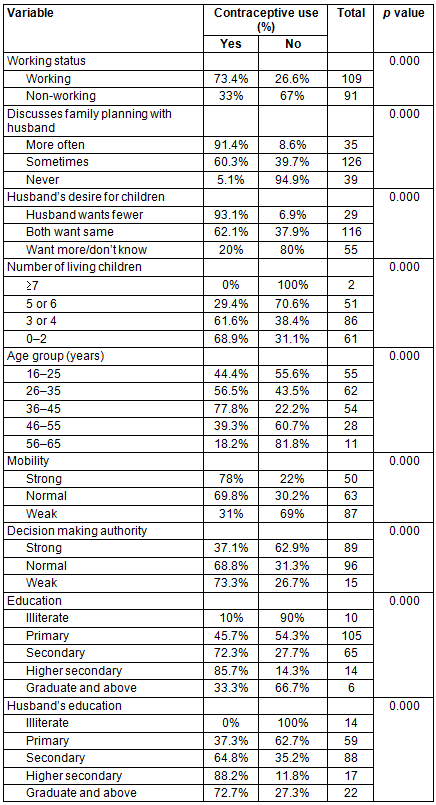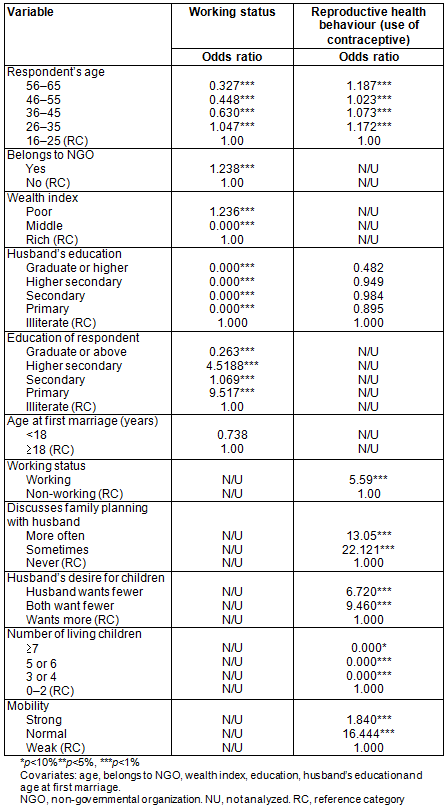Over the past few decades Bangladesh has made unprecedented and rapid progress in several health indicators and outcomes despite spending less on health1. Bangladesh now has the longest life expectancy, lowest total fertility rate and the lowest infant and under-5 mortality rates in south Asia1,2. Bangladesh is one of the most densely populated countries in the world, and in terms of human development it ranks at 129 out of 169 countries3. Almost 40% of people in Bangladesh continue to live below the poverty line4. Most women (90%) live in rural areas and constitute the majority of the poor, experiencing greater deprivation and vulnerability to poverty and socioeconomic adversity due to their low status in society according to reports by UNFPA Bangladesh5. The Government of Bangladesh has achieved success in reducing the total population growth from 2.3% in 1981 to 1.34% in 20116. However, population is still one of the major public health problems of Bangladesh, underpinning the need for better family planning services and understanding the complex reproductive health behavior of its population.
Most rural women in Bangladesh actively contribute to the household activities. However, a great deal of women's activities does not generate direct income. Women's participation in income is usually a function of their poverty7. Income may enhance a woman's position in the family and may increase her autonomy in decision making. Once she earns status and autonomy in family decisions, she will have control over her desired fertility8. There is a need for women's participation in income generating activities in Bangladesh to meet basic needs and improve quality of life in terms of education, health and social improvement beyond simple survival9. Contraceptive use rates among income generating women were 56.1% compared to 40.1% among the non-participant10.
Women's working hours in economic activities were found to be low due to their substantial involvement in non-economic household work. A study in Bangladesh showed 37% of women did not participate at all in economic activities, 38% worked only for up to 2 hours a day and only 6% of women worked for more than 6 hours a day in economic activities, which may be considered as full-time employment10. Women's involvement in livestock rearing and homestead gardening and cottage industries is significantly higher than that of men. Those residing in dispersed rural areas are less likely to find employment other than agricultural wage labor11.
Women's empowerment has been defined as 'the capacity of the women to be economically self sufficient and self reliant with control over decisions affecting their life options and freedom from violence'12. Women's empowerment in Bangladesh is strongly associated with women's working status and financial services13-15. In recent years the rapid influx of women in income generating activities in Bangladesh has become a key factor in the growing independence of women economically, socially and legally and in improving women's empowerment. However, to the best of the authors' knowledge there are no studies showing the relationship between income generating activities of women and reproductive health behavior in Bangladesh. The objective of the study was to find out the association between income generating activities of women and their reproductive health behavior in Bangladesh. The results of the study will help to understand the reasons for involvement in income generating activities of rural women, relationship between work and empowerment, relationship between work, empowerment and fertility and to develop policies for the integrated development of Bangladesh.
Study design and populations
A cross-sectional study was carried out among 200 married rural women from June to December 2010 in Cox's Bazar district of Bangladesh using a multistage sampling technique (Fig1). At the first stage, one district was selected randomly out of the 64 districts in Bangladesh (Cox's Bazar district). At the second stage, one sub-district (Sadar) was selected out of the seven sub-districts and at the third stage one village (Kalampur) was selected randomly out of 163 villages. Cox's Bazar consists of 7 upazilas, 3 municipalities, 27 wards, 58 mahallas, 67 union parishads, 199 mouzas and 975 villages. Cox's Bazar Sadar had a population of 253 788, of whom 117 509 were aged ≥18 years. Males constituted 53.9% of the population, and females 46.1%. Cox's Bazar Sadar had an average literacy rate of 28.3% (≥7 years), against the national average of 32.4%. A total of 220 married women aged ≥16 years were approached for the interview in the selected villages with a 90.9% response rate. Participants were selected by convenience sampling from the village.

Figure 1: Administrative structure of Bangladesh used in study sampling.
Data collection tools and procedure
The study was conducted using a structured questionnaire. The questionnaire was pre-tested in a separate village among 30 married female participants and modified for the study. Eight local graduate female interviewers were recruited and trained to interview the participants with necessary conceptual and contextual understanding. The interviewers carried out a one-to-one interview at each participant's house and maintaining proper confidentiality. The interviewers cross-checked the questionnaire for missing data and inconsistency after the interview. To provide necessary conceptual and systematic support, two supervisors monitored the interview and cross-checked the process regularly.
Variables and definitions
Data were collected on the following variables: sociodemographic characteristics, working status of respondents, empowerment of women in terms of mobility and decision making authority and reproductive behaviour in terms of contraceptive use, discussion of family planning with husband and desire for more children by women and their husbands. In the present study, income generating activities have been defined as those activities that generate income for the household or save household expenditure for the goods from the market11. Mobility is one of the indicators for measuring empowerment of women. It refers to the propensity of a woman to move freely in society. To determine mobility frequency, each respondent was asked if she had ever gone to the market, outside the village and to the hospital/health center. Those who said they travelled outside of their homes were asked if they were accompanied by someone else. Each participant was given one point for each place visited with someone and an additional one point if she reported to have travelled alone. Women having scores of 0-2, 3-4 and 5-6 were considered as weakly, normally and strongly mobile, respectively.
Decision making authority represents women's participation in family decision making such as household purchases, daily food menu, permission to visit relatives, decisions on seeking personal and child healthcare and control over money earned. For all six cases, a woman scored 2 if she made a decision alone, 1 for decision making jointly and 0 for no authority. Women who scored 0-4, 5-8 and 9-12 were considered to have weak, normal and strong decision making authority, respectively.
Data analysis
Data analysis was carried out with the Statistical Package for the Social Sciences v16 (IBM; http://www.spss.com). Univariate analysis was used to illustrate the working pattern of women. Bivariate analysis using χ2 tests was applied to find out the relationship between variables. Multivariate logistic regression analysis was carried out to show the effect of different factors on work, empowerment and reproductive behavior by developing models using maximum likelihood methods. The authors used only those variables in multivariate analysis that were statistically significant in the binary logistic model. The following independent variables were used as covariates in the multivariate analysis: 'age', 'belongs to NGO', 'wealth index', 'education', 'husband's education' and 'age at first marriage'.
Ethics approval
Data collection took place after obtaining written informed consent from each participant. Objectivity of the study and confidentiality were explained to participants. Principles of the Helsinki Declaration were adhered to for data collection. The study was approved by the ethical review board of the Department of Health Economics, University of Dhaka, Bangladesh (IRBDHE 0907128).
In this study, the majority of the participants were first married at the age of 18 years or more (81%), were from poor to middle class (88%) according to wealth index and had some years of formal education (95%). More than half of the women (55%) discussed family planning with their husband and were involved in income generating activities (54.5%). Among working women, 23.1% were involved in business; 21.3% in poultry raising, cattle raising and trading; and 20.4% in agriculture. A great majority of women (63.9%) worked year-round, 34.3% seasonally and 1.9% occasionally. Among the participants, 75% earned cash only for work, 3.7% earned in-kind and 21.3% were not paid. Only one-third of women were members of any non-governmental organization (NGO) in their area (34.4%; Table 1).
Women aged 26-35 years were more (58.1%) involved in income generating activities. NGO members and women from poor families were 1.2 times more likely to be engaged in income generating activities than non-NGO members and those from rich families. Among the working women, most (83.3%) made decisions normally, 15% strongly and 15.7% weakly. Among the non-working women, 84.3% weakly made their decisions. Interspousal communication was strong (76.5%) among working women. Working women were three times more empowered than non-working women.
More than half of the participants (55.0%) were using contraceptives. Contraceptive use was significantly higher among working women (73.4%) than non-working women (33.0%) (p≤0.001). The women who discussed family planning more often (91.4%) and sometimes (60.3%) with their husband were more likely to beusing more contraceptives than those who never discussed it (5.1%). Contraceptive use was higher among women aged 36-45 years (77.8%) and women aged 26-35 years (56.5%) than among age groups 16-25 years (44.4%), 46-55 years (39.3%) and 56-65 years (18.2%). Contraceptive use among women who were strongly mobile (78%) was more than double compared to weakly mobile women (31%). More than half of the women who had normal and strong decision making authority were using contraceptives (Table 2).
There was no significant association between husband's education and contraceptive use in most cases. Contraceptive use was 22 times and 5.6 times higher among women who discuss family planning with their husbands sometimes and more often, respectively, compared to women who never discussed it. The women whose husbands wanted fewer children and those who wanted the same number of children were 6.7 and 9.5 times more likely to use contraceptive respectively than those whose husbands had a desire for more children. Working women were 5.6 times more likely to use a contraceptive method compared to non-working women (p≤0.001). Women who are in the older age group and had more children were more likely to use contraceptives compared to women in the 16-25 years age group and have 0-2 children. Women who were strongly mobile and normally mobile were 1.8 and 16.4 times more likely, respectively, to use contraceptive than those who were weakly mobile (Table 3).
Table 1: Sociodemographic characteristics of respondents

Table 2: Distribution of respondents by reproductive health behavior

Table 3: Logistic regression analysis for working status and reproductive behavior

Discussion
In this study, working women were more empowered than non-working women. Income and empowerment were positively associated with contraceptive use and negatively associated with desire for additional children. So, engagement in income generating activities of rural women is an essential issue for fertility reduction. During the past few decades, changes have taken place in rural areas of Bangladesh that touch women's lives and options most profoundly. These changes have been encouraged by a number of critical economic, demographic and social factors as well as by the government and the NGOs16,17.
In this study, income generating activities are defined as activities that generate income for the household in terms of cash income only. This includes employment in the agricultural and non-agricultural labor market, and also work for the household in crop cultivation, homestead gardening, livestock, and poultry raising, fishing, cottage industry, construction, business, and personal services11. Reproductive behavior can include sexual activity, knowledge about human sexual behavior and so on. In this study, 'reproductive behavior' refers to use of contraceptives, discussing family planning with husband, and childbirth by rural women. Only three indicators to measure women's empowerment were used.
The present study showed that women aged 26-35 years and poor women worked more (58.1%) to earn money. Women's education and that of their husbands are important factors for working18. In this study, highly educated women were working more than others, and the opposite was true for husband's education. Several studies in Bangladesh have also reported the positive response of education for income generating activities for both men and women19. Increased opportunities for people to obtain an education will produce a beneficial impact on the sociodemographic condition of individual households in societies as well as the population at large. Women with longer duration of marriage seem to work more than others. Husband's occupation and age at first marriage and its influence on working status of rural women was insignificant. This may be because a husband's earnings are not sufficient and as a result women have to work whether their husbands are employed or not. Also, in rural areas women usually have less knowledge about reproductive health20 and get married earlier because they have to follow their customs, traditional rules and patriarchal decisions21.
Empowerment is a composite variable and in this study three indicators - mobility, decision making authority and interspousal communication - have been considered for measuring empowerment. Working women are the predominant group in this study, are more mobile, have strong decision making authority and higher interspousal communication. In this study, 16% of working women are strongly empowered compared to no non-working women. Working women contributing to their family welfare increases their decision making power, importance to their husband and ultimately empowerment. Women's involvement in income generating activities reduces economic dependence on men and undermines the risk insurance value of children, leading to desire for lower fertility. Further, income generating activities makes women empowered, and empowered women are better able to cross different socioeconomic barriers22,23.
Work directly and indirectly influences women's reproductive behavior. Fertility is a micro- as well as macro-level phenomenon. Working women are expected to be more concerned with their own reproductive health needs and know more about family planning24-26. In the present study, strongly mobile women are the predominant group who use more contraceptives and desire smaller family sizes. Competing roles give women greater access to extra familiar sources of information and resources, increasing their potential autonomy in reproductive decision making and use of contraceptives. Demand for children was generally negatively associated with women's status27. In this study, decision making authority shows insignificant association with reproductive behavior. This may be because women have no authority to make decisions on family planning issues in Bangladeshi society. Also, education was found to have no influence on contraceptive and desire for additional children, which might be related to strong local customs as found in a recent study28. The relationship between women's fertility level and employment is complex but there are certain aspects of the relationship that can be understood and subjected to programs and policies that may enable women to fulfil their multiple roles in a less strained and more equitable environment.
The government of Bangladesh and its development partners have achieved success in reducing the total fertility rate from 5 in the 1980s to 2.3 in 2011 and total population growth from 2.3% in 1981 to 1.3% in 2011. However, the contraceptive prevalence rate for use of modern contraceptives has increased only slightly between 2004 and 2007 (from 47.3% to 47.5%, with 52.5% of married women not currently using any form of contraception). At the same time the unmet need for family planning has increased from 11% to 17%, underpinning the need for better family planning services29.
One limitation of the present study is that responses by women may be affected by social desirability bias. Thus responses on women's empowerment may not reflect the facts. This study collected information from women only and not their husbands and family members (which could provide further information). Reproductive health behavior was limited to questions on contraceptive use, family planning and childbirth only, and the authors deliberately excluded questions on sexual activities, desire, performance and satisfaction.
This study shows that women's involvement in income generating activities increases empowerment and reduces fertility. This might be one of the key issues for changing the life of rural women in Bangladesh and ensuring gender equity. National policies should increase scope for income generating activities of rural women, which will help to improve their reproductive health behavior, fertility control and contribute to the economic development of the country.
Acknowledgement
The authors acknowledge the support by the Faculty of Health Economics, University of Dhaka to support this study; and the editor and reviewers of this article for their valuable comments and suggestions.
References
1. Das P, Horton R. Bangladesh: innovating for health. The Lancet 2013; 382(9906): 1681-1682.
2. Chowdhury AMR, Bhuiya A, Chowdhury ME, Rasheed S, Hussain Z, Chen LC. The Bangladesh paradox: exceptional health achievement despite economic poverty. The Lancet 2013; 382(9906): 1734-45.
3. Rende S, Donduran M. Neighborhoods in development: human development index and self-organizing maps. Social Indicators Research 2013; 110(2): 721-734.
4. Khan MMH, Zanuzdana A, Kraemer A. Levels, trends and disparities in public-health-related indicators among reproductive-age women in Bangladesh by urban-rural and richest-poorest groups, 1993-2011. PloS One 2013; 8(9): e75261.
5. Hadi A. Women's productive role and marital violence in Bangladesh. Journal of Family Violence 2005; 20(3): 181-189.
6. Akhtaruzzaman M, Khan MNI, Islam SN. Nutrition, health and demographic survey of Bangladesh - 2011. Dhaka: Institute of Nutrition and Food Science, University of Dhaka, 2013.
7. Rahman HZ, Hossain M, Sen B. 1987-1994: Dynamics of rural poverty in Bangladesh. Analysis of Poverty Trends Project. 1996.
8. Schuler SR, Hashemi SM, Riley AP. The influence of women's changing roles and status in Bangladesh's fertility transition: evidence from a study of credit programs and contraceptive use. World Development 1997; 25(4): 563-575.
9. Amin R, Ahmed A, Chowdhury J, Ahmed M. Poor women's participation in income-generating projects and their fertility regulation in rural Bangladesh: evidence from a recent survey. World Development 1994; 22(4): 555-565.
10. Goetz AM, Gupta RS. Who takes the credit? Gender, power, and control over loan use in rural credit programs in Bangladesh. World Development 1996; 24(1): 45-63.
11. Hossain M, Bose ML, Ahmad A. Nature and impact of women's participation in economic activities in rural Bangladesh: insights from household surveys. Working papers. Sweden: Lund University, 2004.
12. Rao A, Kelleher D. Engendering organizational change: the BRAC case. IDS Bulletin 1995; 26(3): 69-78.
13. Hashemi SM, Schuler SR, Riley AP. Rural credit programs and women's empowerment in Bangladesh. World Development 1996; 24(4): 635-653.
14. Kabeer N. Resources, agency, achievements: reflections on the measurement of women's empowerment. Sida Studies No. 3. Stockholm: Swedish International Development Agency, 2001.
15. Mahmud S, Razzaque A, Nahar L. Women's empowerment and reproductive change in rural Bangladesh. Dhaka: Bangladesh Institute of Development Studies, 2001.
16. Sinha S, Matin I. Informal credit transactions of micro credit borrowers in rural Bangladesh. IDS Bulletin 1998; 29(4): 66-80.
17. Steele F, Amin S, Naved RT. The impact of an integrated micro-credit program on women's empowerment and fertility behavior in rural Bangladesh. Population Council, Policy Research Division, 1998.
18. Kumskova NH. Strengthening income-generating opportunities for rural women in Kyrgyzstan. 1999.
19. Khan SR, Chowdhury AMR, Ahmed SM, Bhuiya A. Women's education and employment: Matlab experience. Asia Pacific Population Journal 1996; 11: 45-58.
20. Mou SZ, Bhuiya FA, Islam SMS. Knowledge and perceptions of sexually transmitted diseases, HIV/AIDS, and reproductive health among female students in Dhaka, Bangladesh. International Journal of Advanced Medical and Health Research 2015; 2(1): 9.
21. Amin S. The poverty's purdah trap in rural Bangladesh: implications for women's roles in the family. Development and Change 1997; 28(2): 213-233.
22. Naved RT. Empowerment of women: listening to the voices of women. The Bangladesh Development Studies 1994: 155-78.
23. Mainuddin A, Begum HA, Rawal LB, Islam A, Islam SS. Women empowerment and its relation with health seeking behavior in Bangladesh. Journal of Family & Reproductive Health 2015; 9(2): 65.
24. Stycos JM, Weller RH. Female working roles and fertility. Demography 1967; 4(1): 210-217.
25. Chaudhury RH. The influence of female education, labor force participation, and age at marriage on fertility behavior in Bangladesh. Biodemography and Social Biology 1984; 31(1-2): 59-74.
26. Zheng Z, Zhou Y, Zheng L, Yang Y, Zhao D, Lou C, et al. Sexual behaviour and contraceptive use among unmarried, young women migrant workers in five cities in China. Reproductive Health Matters 2001; 9(17): 118-127.
27. Bongaarts J. A framework for analyzing the proximate determinants of fertility. Population and Development Review 1978: 105-132.
28. Bilkis S. Women's education, employment and empowerment: analysis of interrelationships. Empowerment: A Journal of Women for Women 2004; 11: 45.
29. United Nations Population Fund Bangladesh. About Bangladesh. (Online) 2014. Available: http://unfpabgd.org/index.php?option=page&id=49&Itemid=4 (Accessed 29 December 2014).
